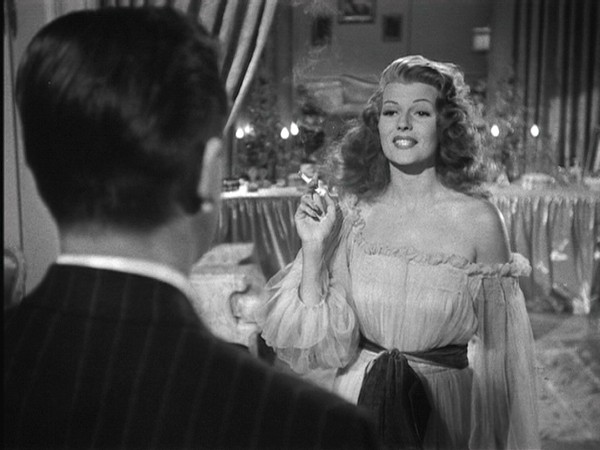← Back to Reviews
in
Gilda
Rita Hayworth had a long and distinguished career as the queen of Columbia, but found her signature role in the 1946 melodrama Gilda, a steamy romantic triangle co-mingled with a mob drama that doesn't entirely sustain interest until the end, but the alluring Hayworth makes it worth the watch.

Glenn Ford stars as Johnny Farrell, a penniless professional gambler who arrives in Argentina and has his life saved one night by a wealthy casino owner named Ballin Mudson (George Macready), who hires Johnny at the casino as his right hand man. Everything is going well for Johnny until Mudson returns from a business trip with a new bride, an icy seductress named Gilda (guess who) who is immediately attracted to Johnny and vice versa, though both fight it as hard as they can.

Marion Parsonnet's screenplay is surprisingly adult for 1946...the dialogue between Johnny and Gilda is rich with sexual double entendres and I loved the fact that in the parts of the story centered around the triangle, none of the three characters ever say exactly what they mean. I also love the way the word "hate" is substituted for the word "love" when Johnny and Gilda get honest about their feelings for each other. If I had one quibble with the screenplay, we could have done without Johnny's narration...it was unnecessary and added nothing to the story.

What does work here is Rita Hayworth in a role that seems to have been written for her and the white hot chemistry between her and Ford, which ignite the screen through the sensitive and intense direction by Charles Vidor. The second Gilda and Johnny lay eyes on each other, the attraction is there with a sexual tension you can cut with a knife. I love when Gilda is dancing with another man and the whole time she's dancing with this guy, her eyes never leave Johnny sitting at the table...that's Hayworth and Vidor establishing the story pretty much in one scene. The third part of the triangle is not given short shrift either...Vidor makes it clear that Mudson sees the attraction and all the insecurities he has about his marriage come bubbling to the service. I love after their first meeting the way he tries to convince both Johnny and Gilda that they "hate" each other.
_NRFPT_05.jpg)
The final third of the film which concentrates on the mob part of the story doesn't work as well, but it does contain a scene that's become part of movie pop culture. Hayworth's sexy and brassy interpretation of "Put the Blame on Mame" is something that has to be experienced (her singing is dubbed by Anita Ellis). This scene alone is probably a big reason why Rita Hayworth will always be remembered as Gilda. And nobody does a hair toss like Rita.

The chemistry that Hayworth creates with Ford is no accident. since this was the second of five films they made together. Macready was overly mannered as Mudson, but it seemed to fit the character and I also enjoyed Steven Geray as Uncle Pio, the philosophical bartender. Kudos to the art direction/set direction and to Hayworth's stunning wardrobe by Jean Louis. It's not a home run. but Hayworth definitely makes this classic worth investing in.
Rita Hayworth had a long and distinguished career as the queen of Columbia, but found her signature role in the 1946 melodrama Gilda, a steamy romantic triangle co-mingled with a mob drama that doesn't entirely sustain interest until the end, but the alluring Hayworth makes it worth the watch.

Glenn Ford stars as Johnny Farrell, a penniless professional gambler who arrives in Argentina and has his life saved one night by a wealthy casino owner named Ballin Mudson (George Macready), who hires Johnny at the casino as his right hand man. Everything is going well for Johnny until Mudson returns from a business trip with a new bride, an icy seductress named Gilda (guess who) who is immediately attracted to Johnny and vice versa, though both fight it as hard as they can.

Marion Parsonnet's screenplay is surprisingly adult for 1946...the dialogue between Johnny and Gilda is rich with sexual double entendres and I loved the fact that in the parts of the story centered around the triangle, none of the three characters ever say exactly what they mean. I also love the way the word "hate" is substituted for the word "love" when Johnny and Gilda get honest about their feelings for each other. If I had one quibble with the screenplay, we could have done without Johnny's narration...it was unnecessary and added nothing to the story.

What does work here is Rita Hayworth in a role that seems to have been written for her and the white hot chemistry between her and Ford, which ignite the screen through the sensitive and intense direction by Charles Vidor. The second Gilda and Johnny lay eyes on each other, the attraction is there with a sexual tension you can cut with a knife. I love when Gilda is dancing with another man and the whole time she's dancing with this guy, her eyes never leave Johnny sitting at the table...that's Hayworth and Vidor establishing the story pretty much in one scene. The third part of the triangle is not given short shrift either...Vidor makes it clear that Mudson sees the attraction and all the insecurities he has about his marriage come bubbling to the service. I love after their first meeting the way he tries to convince both Johnny and Gilda that they "hate" each other.
_NRFPT_05.jpg)
The final third of the film which concentrates on the mob part of the story doesn't work as well, but it does contain a scene that's become part of movie pop culture. Hayworth's sexy and brassy interpretation of "Put the Blame on Mame" is something that has to be experienced (her singing is dubbed by Anita Ellis). This scene alone is probably a big reason why Rita Hayworth will always be remembered as Gilda. And nobody does a hair toss like Rita.

The chemistry that Hayworth creates with Ford is no accident. since this was the second of five films they made together. Macready was overly mannered as Mudson, but it seemed to fit the character and I also enjoyed Steven Geray as Uncle Pio, the philosophical bartender. Kudos to the art direction/set direction and to Hayworth's stunning wardrobe by Jean Louis. It's not a home run. but Hayworth definitely makes this classic worth investing in.
